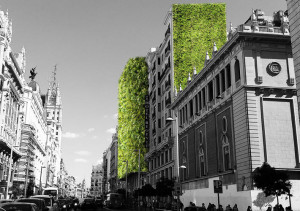Source: fastcoexist.com
Published: February 3, 2016

In Madrid, pretty much every unused space will soon be covered in plants. All Renderings: Arup
Vacant lots, city squares, a former highway, and even regular city streets are going to be filled up with trees and plants–everywhere you look.
In Madrid, pretty much every unused space will soon be covered in plants.
The city is spending millions to expand existing parks, and as many roofs and walls will be covered with greenery as possible. Twenty-two vacant lots will be turned into urban gardens. Paved squares will become parks that can suck up rainfall. Near the river that runs through the middle of the city–where a major highway was torn down in 2003–the city is spending over $4.3 million to finish filling in the banks with trees.
As the city starts to ban cars from central streets, the Department of the Environment is considering turning some of those streets into linear, tree-filled parks, too.

It’s all part of sweeping plan to help adapt to some of the biggest challenges the city faces from climate change: More blisteringly hot days, more severe drought, and–when it does rain–heavier floods.
“The idea is that over time as these interventions increase they will work together–and work with other larger city climate change schemes and projects–to help build vital climate change resilience at a larger scale up to city scale,” says Tom Armour, director of global landscape architecture for Arup, the design and engineering firm that worked with Madrid to create a long menu of ways the city can prepare by integrating more nature into the concrete.
Madrid has always been hot in the summer, but it’s getting hotter. During a heat wave in 2015, 104-degree days broke the city’s all-time records for the month of June and July. Heat waves that used to happen once every two decades now happen every five years. By 2050, there will be 20% more unusually hot days in the summer, and it will rain 20% less.

Each of the planned changes in landscaping can help. Planting gardens on roofs, and adding plants on outdoor walls, helps insulate buildings so they can save energy, and helps reduce street noise. But it also helps bring down local temperatures by shading pavement and by releasing evaporated water that can create clouds. In pilot green roof tests in some Madrid neighborhoods, temperatures went down more than four degrees. Replacing paved squares with plantings that can absorb and store water will help the city cope with more frequent heavy rain.
“The improvements presented are practical and effective and can be undertaken across the city in many locations,” says Armour. “They are buffer, localized solutions aimed to adapt the city to the different effects of climate change scenarios to build resilience.”

Though drought will be more common, the city can handle more plants. By redesigning paved areas to capture and store water instead of letting rain run off, the city can supply all of the gardens with as much water as they need. And choosing the right plants for Madrid’s arid climate also matters.
“Green areas should not be idealized as ‘green’ themselves,” says Susana Saiz, senior project manager for the sustainability department in Arup’s Madrid office. The solutions may look brown at some times of the year, same as the surrounding natural areas. The point is to go with nature patterns and solutions, not forcing them in any manner for the purpose of achieving a certain look.”
Adding vegetation can also help the city with its smog problem. Madrid, one of the most polluted cities in Europe, bans some traffic and makes public transit free on the filthiest days, and will ban diesel cars in the city center by 2020. Plants can help more, because keeping the temperature cooler helps prevent ozone-forming pollution. A 2015 study suggested that “industrial-scale” tree planting is an important way that cities can fight pollution.
What’s happening in Madrid should happen everywhere, says Armour. “[The changes] would need to be adapted to the specific needs of each city and climate, but many of the solutions are universal,” he says. “Current research is showing that nature-based solutions like these proposed can result in multiple co-benefits for health, the economy, society and the environment, and thus they can often represent more efficient and cost-effective solutions than more traditional approaches.”
All Renderings: Arup
